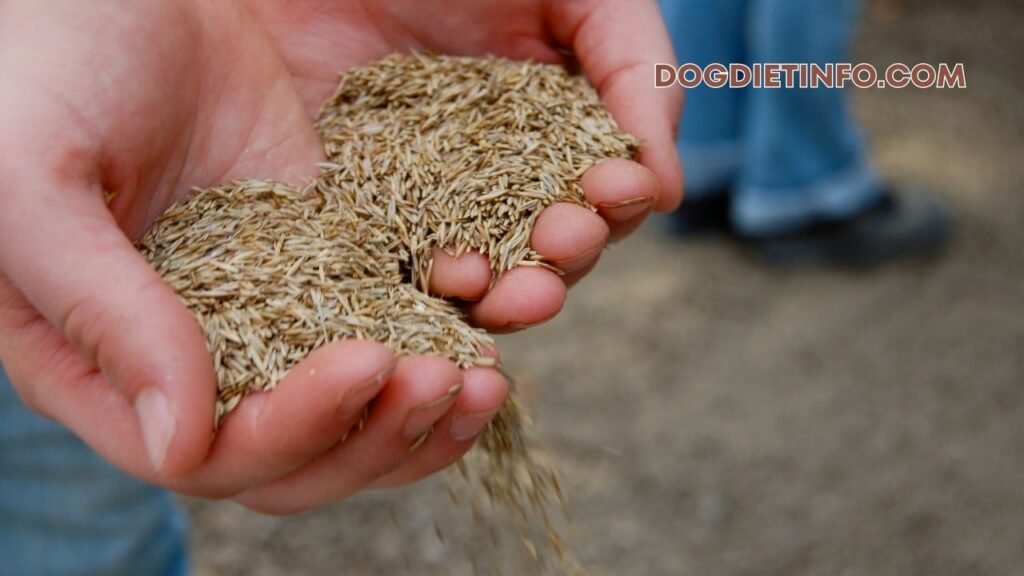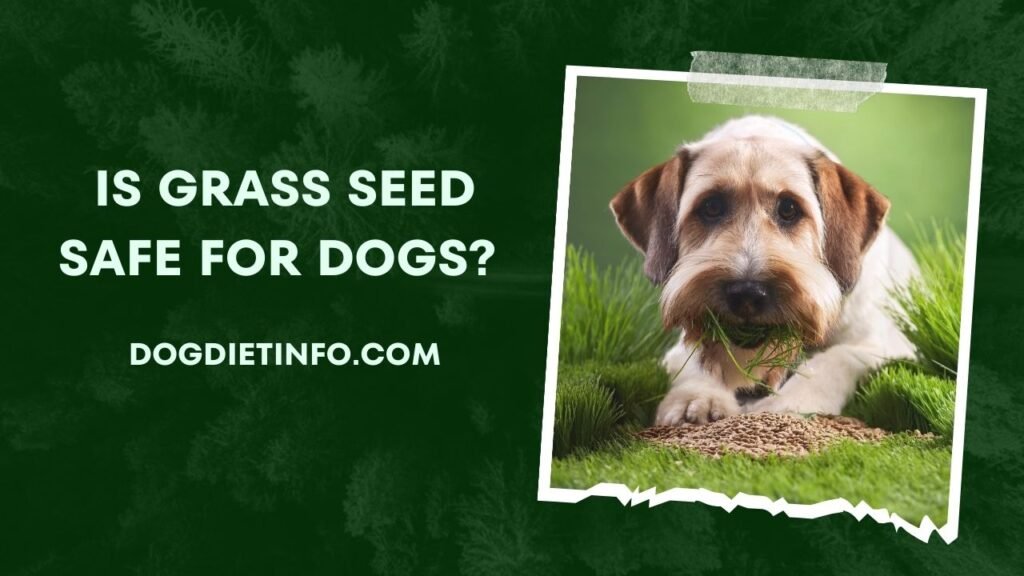Is Grass Seed Safe For Dogs? Grass seed is generally safe for dogs, but certain seeds can cause irritation if they get stuck in their paws, ears, or skin.
Dogs love spending time outdoors, running through the grass, and exploring their environment. As a dog owner, it’s natural to wonder if the grass and its seeds are entirely safe for your pet.
While grass itself isn’t usually harmful, grass seeds can pose some risks that are important to understand.
In this comprehensive article, we will dive into whether grass seed is safe for dogs, the problems it can cause, and how to protect your furry companion from potential harm.
Contents
What Are Grass Seeds?
Definition:
Grass seeds are the small reproductive parts of grasses that allow them to spread and grow. [Is Grass Seed Safe For Dogs?]
These seeds are often dispersed naturally by the wind, animals, or human activities.
Gardeners and landscapers also plant grass seeds intentionally to cultivate healthy lawns and parks.
Types of Grass Seeds:
There are several different types of grass seeds, each suited to different climates, soil types, and uses. Common grass types include:
- Ryegrass: Known for its durability and quick growth, ryegrass is often used in lawns, sports fields, and parks. It is particularly common in cooler climates.
- Fescue: Fescue grasses thrive in shaded areas and cooler environments, making them a popular choice for gardens with trees or in regions with less direct sunlight.
- Bermuda Grass: Bermuda grass is a warm-season grass that’s hardy and thrives in hot climates. It’s often used in lawns, golf courses, and sports fields.
- Kentucky Bluegrass: Popular in lawns and recreational areas, this cool-season grass is prized for its deep green color and soft texture.
- Zoysia Grass: A dense, drought-resistant grass that’s often used in both residential and commercial landscapes.
While grass seeds are vital for keeping lawns lush and green, they can sometimes cause unexpected problems for our dogs.
Are Grass Seeds Safe for Dogs?
General Safety:
In general, grass seeds themselves are not toxic or dangerous to dogs. Your dog can run, roll, and play on grassy areas without any issues most of the time.
However, the seeds can become a problem if they get lodged in sensitive areas of your dog’s body, such as their paws, ears, or eyes.
Potential Risks:
While grass seeds don’t pose an immediate danger, their small size and sharp edges can make them harmful when they come into contact with your dog’s skin or fur.
These seeds can easily get trapped between the toes, embedded in the skin, or inhaled into the nose or ears. [Is Grass Seed Safe For Dogs?]
Once inside, they can cause pain, irritation, and even infections. In some cases, the seeds can migrate deeper into the body, leading to more serious complications.

Common Problems Caused by Grass Seeds
Grass seeds, due to their barbed and pointed shape, can be particularly troublesome for dogs when they get stuck in areas that are difficult for the dog to reach. Here are some of the most common issues that can arise:
1. Injuries to Paws and Skin
The most common area where grass seeds cause problems is in your dog’s paws. The spaces between a dog’s toes are perfect places for small seeds to get lodged.
If a seed becomes stuck, it can penetrate the skin and cause redness, swelling, and pain. [Is Grass Seed Safe For Dogs?]
Your dog may limp or excessively lick the affected paw in an attempt to remove the seed. Left untreated, these injuries can lead to abscesses or infections.
Signs to Look For:
- Limping or favoring one paw
- Excessive licking or biting at the paw
- Redness or swelling between the toes
- Visible sores or pus, which could indicate infection
2. Ear and Nose Problems
Grass seeds can also enter your dog’s ears or nose, causing irritation and potentially leading to more serious issues if they are not removed.
Seeds lodged in the ear can cause your dog to shake their head, scratch at the ear, or tilt their head to one side. [Is Grass Seed Safe For Dogs?]
In some cases, the seed can work its way into the ear canal, causing pain, infection, or even damage to the eardrum.
Similarly, if a grass seed gets inhaled through the nose, it can cause sneezing, nasal discharge, or even difficulty breathing if it moves deeper into the nasal passage.
Signs to Look For:
- Persistent head shaking or ear scratching
- Tilting the head to one side
- Discharge or foul odor from the ear
- Sneezing or nasal discharge
- Difficulty breathing or coughing
3. Eye Irritation
Grass seeds can also get into your dog’s eyes, causing irritation, redness, and discomfort. [Is Grass Seed Safe For Dogs?]
In some cases, the seed may scratch the cornea, leading to more serious eye conditions that require medical attention.
Dogs with grass seeds in their eyes may squint, paw at their face, or have watery eyes.
Signs to Look For:
- Squinting or keeping one eye closed
- Pawing at the face or rubbing the eyes
- Redness or swelling around the eyes
- Excessive tearing or discharge
4. Digestive Issues
While less common, dogs may accidentally ingest grass seeds while playing or eating grass. Swallowed seeds can cause irritation or blockages in the digestive tract, depending on their size and shape.
If your dog shows signs of gastrointestinal distress, such as vomiting, diarrhea, or loss of appetite, it’s important to consult a vet.
How to Protect Your Dog from Grass Seeds
As a responsible pet owner, there are several steps you can take to protect your dog from the potential risks posed by grass seeds. [Is Grass Seed Safe For Dogs?]
1. Choose Pet-Friendly Grass Types
Certain types of grass are less likely to produce harmful seeds. For example, fescue grass is generally considered safer for dogs because it produces fewer barbed seeds than other types like Bermuda grass.
When planning your garden or lawn, consider choosing grass varieties that are less likely to pose a risk to your pet.
2. Regular Inspections After Outdoor Play
One of the simplest ways to protect your dog from grass seeds is by regularly inspecting them after they’ve been outside.
Pay special attention to their paws, ears, and coat. Gently check between their toes, look inside their ears, and brush through their fur to remove any debris.
If your dog has a long or thick coat, consider trimming it during the summer months when grass seed exposure is more likely.
This can make it easier to spot and remove any seeds before they cause a problem. [Is Grass Seed Safe For Dogs?]
3. Keep the Lawn Well-Maintained
Maintaining your lawn by mowing it regularly and cleaning up any excess grass seed debris can reduce the chances of seeds sticking to your dog’s fur or paws.
Shorter grass is less likely to produce loose seeds that can get stuck in your dog’s body. [Is Grass Seed Safe For Dogs?]
If possible, avoid taking your dog to areas where grass is particularly tall or dry, as these are prime environments for grass seed exposure.
4. Use Protective Gear
If your dog frequently encounters grass seeds during their outdoor activities, you might consider using protective gear such as dog boots or paw covers. These can help prevent seeds from getting lodged in your dog’s paws.
Additionally, some breeds with long or floppy ears may benefit from ear protection to prevent seeds from getting stuck in the ear canal.
What to Do if a Grass Seed Injures Your Dog
Grass seed injuries can range from mild irritation to more serious conditions requiring veterinary care. Here’s what to do if you suspect your dog has been injured by grass seeds:
1. Recognizing Symptoms
Keep an eye out for the following symptoms that could indicate a grass seed injury:
- Limping or favoring a paw
- Excessive licking or biting at the affected area
- Redness, swelling, or discharge
- Persistent sneezing, coughing, or difficulty breathing
- Head shaking or ear scratching
- Squinting, pawing at the face, or eye discharge
2. Immediate Actions
If you notice a grass seed lodged in your dog’s fur, paw, or ear, you can attempt to remove it carefully using tweezers.
Be gentle and make sure to grab the seed firmly by the base to avoid breaking it off. [Is Grass Seed Safe For Dogs?]
If you’re unable to remove the seed or if it’s embedded deep in the skin or ear, it’s best to seek veterinary assistance to avoid further complications.
3. Veterinary Treatment
In some cases, grass seeds can migrate into the body, causing more serious infections or abscesses.
If your dog is showing signs of infection, such as swelling, pus, or fever, it’s crucial to take them to a vet for proper treatment.
The vet may need to surgically remove the seed or prescribe antibiotics to prevent or treat infections.
Final Verdict
Grass seeds can pose a variety of risks to dogs, from minor irritations to more severe injuries. [Is Grass Seed Safe For Dogs?]
While most grass seeds are not inherently dangerous, their sharp edges and barbed texture can cause problems if they become embedded in your dog’s paws, ears, or skin.
By choosing safer grass types, inspecting your dog regularly, and keeping your lawn well-maintained, you can significantly reduce the risk of grass seed-related injuries.
Remember, if you notice any signs of discomfort or injury in your dog, it’s always best to consult with a veterinarian to ensure the issue is properly addressed.
See Also: Are Quail Eggs Good For Dogs?
FAQs
Can grass seeds harm a dog’s skin?
Yes, grass seeds can penetrate a dog’s skin, leading to discomfort, irritation, and infections if left untreated. [Is Grass Seed Safe For Dogs?]
What should I do if my dog eats grass seeds?
If your dog eats a small number of grass seeds, it will likely pass through their system without issue. However, if your dog shows signs of digestive distress, such as vomiting or diarrhea, contact your veterinarian.
How can I tell if a grass seed is stuck in my dog’s paw?
Signs of a grass seed stuck in a paw include limping, excessive licking, and swelling between the toes. Check the area for visible seeds and seek veterinary help if needed.
Are there specific grass types that are safer for dogs?
Yes, certain grass types like fescue produce fewer harmful seeds, making them safer for dogs than more aggressive grasses like Bermuda grass.
When should I take my dog to the vet for a grass seed injury?
If you notice signs of infection, such as swelling, pus, or persistent irritation, or if a seed is embedded in a sensitive area like the ear or eye, it’s time to visit the vet.
Conclusion: Is Grass Seed Safe For Dogs?
Grass seeds may seem harmless, but they can pose significant risks to dogs if they get lodged in sensitive areas like paws, ears, or eyes.
By taking simple preventive measures like inspecting your dog after outdoor play, choosing pet-friendly grass types, and maintaining your lawn, you can minimize the risk of injury.
Always be mindful of any signs of discomfort in your dog, and don’t hesitate to seek veterinary care if needed. [Is Grass Seed Safe For Dogs?]

Derrick Wilcox is a certified canine behaviorist with over 12 years of experience at Happy Paws Animal Clinic and Pawsitive Training Center, helping pet owners ensure safer, healthier, and happier lives for their dogs.



